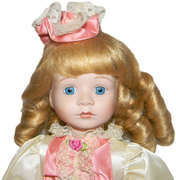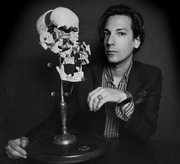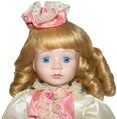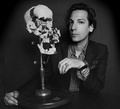Behold the power of the Ouija board. For more than a century, it’s prompted obsessive debate. Is it just a silly adolescent slumber-party board game, leftover from those superstitious Victorians? Is it truly a tool for connecting to spiritual worlds we don’t understand? Is it harmless, helpful, or dangerous? Of course, we’re as fascinated as everyone else with the strange history of these “talking boards.”
Show & Tell regular, Lynda Abbott, known as Vestaswind and a blogger at Appraise Your Junk, piqued our interest when she posted a couple of great vintage “talking boards” from her collection. She explains, “My obsession with Ouija really started in 1999, when Parker Brothers stopped making the old boards and went to the glow-in-the-dark version. It was an end to an era, making even the newest of old Ouija boards in demand.
“At the time, a friend of mine showed me her collection of Ouija boards, and that’s when I realized I had no idea just how many were out there,” she continues. “From that moment on, I knew I had to have them all. Now, I have about 20 boards. I even wrote to Raymond Buckland who wrote ‘Ouija, Yes! Yes!’ and designed his own board. He sent me his book, autographed. For me, the appeal isn’t just the mystery of the board, but the art and the history. In truth, I only get them out to use them if a girlfriend or my sister asks.”
The origins of the modern-day American Ouija board are quite mysterious, though, with many disputed tales about who the actual inventor of the board was, and how he came up with it. According to our Hall of Fame site, Museum of Talking Boards, in the mid-1800s, two sisters claimed to talk to the spirit of a dead salesman, and that sparked a craze for communicating with the dead, called Spiritualism, that spread like wildfire across the U.S. and Europe. Some “mediums” even took down messages via “spirit writing,” using a pencil attached to a small basket, which eventually became a heart-shaped “planchette.”
Other means of talking to ghosts were much more inefficient, requiring taking down notes from Morse Code-like knocks, taps, and rattles of a shaking table. It wasn’t long before crafty inventors came up with devices that let supposed spirits leave alphabetic messages much more readily. Those included dial-plate instruments, psychographs, and, finally, talking boards.
A 1920 article in the New York World Magazine had this piece of folklore about Chestertown, Maryland, cabinet-maker Ernest Charle Reiche inventing the board in 1890: “Mr. Reichie, although not a spiritist, noticed sympathetically that a large table was a heavy thing for a frail spirit to juggle about. His meditations, attuned to cabinetmaking, took a practical form. He devised a little table – the ouija board.”
Another legend, found in the same article, says the same year, Charles W. Kennard, a Chestertown entrepreneur who had previously started ventures in fertilizers and real estate, “sat idly in the kitchen of his Maryland home. … In this blissful state he reached out and took his wife’s breadboard and placed it on his lap, and then placed a saucer on the bread board. The saucer began to move, as though on its own volition. Mr. Kennard was amused, frightened, interested, impressed, inspired and delighted. He saw both spooks and commercial possibilities.” Yet another article, appearing in the New York Daily Tribune in 1886, says the handmade “talking board” craze was spreading across Ohio, four years prior to its supposed invention.
In fall 1890, Kennard went into business with fellow Masons Harry Welles Rusk, William H.A. Maupin, Col. Washington Bowie, and John T. Green as the Kennard Novelty Company in Baltimore. Early in 1891, Kennard and Maupin acquired the rights to the first U.S. talking board patent, registered by Elijah J. Bond, and sold their interest in it to the company. It wasn’t long before Bowie dismissed everyone but Rusk, and put his close pal William Fuld in charge of the renamed Ouija Novelty Company. Some might call this a hostile takeover.
Kennard went on to patent and manufacture other talking boards, including the Volo (1892) and the Igili (1897), and other knockoffs soon followed. Over the decades, these often were printed with mystical images of pyramids, swamis and exotic locales or Halloween-themes like black cats, witches, and devils.
Abbott explained to me that Fuld also liked to brag he invented the Ouija. However, even before the Victorian craze of mysticism, similar talking boards had been in use much longer, the origins dating back centuries in China. In fact, some ancient Daozang scriptures are thought to be derived from “automatic planchette writing” or “spirit writing.” Be that as it may, Fuld was clever enough to notice the trend and capitalize on it, which paid off handsomely.
“Fuld also told the tale of the board giving him advice in business dealings,” Abbott says. “I guess it’s all in what you believe. I believe he was a smart business man—other than that who knows?”
If you believe that Fuld was actually taking instructions from his Ouija board—and not just hyping his product—you might be inclined to think an unfriendly spirit was giving out the orders despite his financial success. Fuld ended up in a long and bitter business dispute with his brother, Isaac, over the production of the Ouija board. Even his 1927 death is shrouded in mystery. One account states, “William Fuld was tragically killed by complications falling from the roof of his three story Harford, Lamont, and Federal Street factory. The iron support he was leaning on gave way, and he tumbled backwards off the roof.” However, some suggested the fall wasn’t an accident at all, and possibly suicide. In particular, those who believed the boards to be evil thought “the devil’s oracle” drove him to it.
After this death, the Fuld family held the patent until they sold it to Parker Brothers in 1966. In 1940s, companies like Haskelite Manufacturing Corporation, Gift Craft, and Lee stepped into the void, producing the Egyptian-themed Hasko Mystic Board and Mystic Trays, the Swami, and Lee’s Magic Marvel.
Parker Brothers happened to be located in Salem, Massachusetts, home to the famous Salem Witch Trials, when it took over the manufacture of the Ouija board, coining the tagline, “It’s just a game, isn’t it?”
For collectors, the game keeps getting better. “The boards I bought 10 years ago have tripled in price,” Abbott says. “It’s a fun part of our history when mystics and séances were all the rage. I see it as the rebellious fad of the 1800s, giving Fuld a rock-star status of his day.”
(Images courtesy Lynda Abbott)




 Mummies and Monkey Skulls: 'Oddities' Host Ryan Matthew Cohn on Creepy Antiques
Mummies and Monkey Skulls: 'Oddities' Host Ryan Matthew Cohn on Creepy Antiques
 Could Your Stuff Be Haunted? Ghostbusting the Creepiest Antiques
Could Your Stuff Be Haunted? Ghostbusting the Creepiest Antiques Mummies and Monkey Skulls: 'Oddities' Host Ryan Matthew Cohn on Creepy Antiques
Mummies and Monkey Skulls: 'Oddities' Host Ryan Matthew Cohn on Creepy Antiques Hellfire and Damnation in Your Back Pocket
Hellfire and Damnation in Your Back Pocket Board GamesBoard games as we know them emerged out of the Victorian Era, even though n…
Board GamesBoard games as we know them emerged out of the Victorian Era, even though n… Mari Tepper: Laying it on the Line
Mari Tepper: Laying it on the Line Nice Ice: Valerie Hammond on the Genteel Charm of Vintage Canadian Costume Jewelry
Nice Ice: Valerie Hammond on the Genteel Charm of Vintage Canadian Costume Jewelry How Jim Heimann Got Crazy for California Architecture
How Jim Heimann Got Crazy for California Architecture Modernist Man: Jock Peters May Be the Most Influential Architect You've Never Heard Of
Modernist Man: Jock Peters May Be the Most Influential Architect You've Never Heard Of Meet Cute: Were Kokeshi Dolls the Models for Hello Kitty, Pokemon, and Be@rbrick?
Meet Cute: Were Kokeshi Dolls the Models for Hello Kitty, Pokemon, and Be@rbrick? When the King of Comedy Posters Set His Surreal Sights on the World of Rock 'n' Roll
When the King of Comedy Posters Set His Surreal Sights on the World of Rock 'n' Roll How One Artist Makes New Art From Old Coloring Books and Found Photos
How One Artist Makes New Art From Old Coloring Books and Found Photos Say Cheese! How Bad Photography Has Changed Our Definition of Good Pictures
Say Cheese! How Bad Photography Has Changed Our Definition of Good Pictures Middle Earthenware: One Family's Quest to Reclaim Its Place in British Pottery History
Middle Earthenware: One Family's Quest to Reclaim Its Place in British Pottery History Fancy Fowl: How an Evil Sea Captain and a Beloved Queen Made the World Crave KFC
Fancy Fowl: How an Evil Sea Captain and a Beloved Queen Made the World Crave KFC
Don’t forget to add the Pink Ouija Board (from Hasbro) to your collection. Google it and see the controversy it created
I have to admit I had not seen this. All I can say is Wow! All in all I’m not surprised by it however. Still the Ouija has caused controversy from it’s birth. Fuld would of been happy with the free adverstising! I’ll have to get one before they are gone!
Nice Post. This transmit helped me in my college assignment. Thnaks Alot
I have used different vintage Ouija boards for several years. Recently, I purchased an original 1891 Kennard Ouija board and original paddle planchette (120 years old and full of energy) and tried using it the same way I use my other boards. The energy is too intense, and I have tried several times to calm the boards energy to use and get results. It’s a little frustrating, because I consider myself an intermediate practitioner using Ouija boards. If there was something I could do to enable the boards capabilities, I would try anything. Any suggestions? If I can’t use it at all, I’d rather sell it to someone who has more experience than I that can tap into its powers & get better use out of it.
Henry, would be interested in trying your board/planchette out. Have extension experience with older boards. mrb1090 at gmail dot com
I have watched with amazment as two of my friends used a brand name store bought board which led to some creepy activity one evening. First they asked the spirit if it was in the house. Yes. Where are you spirit? In the bell. Where is the bell? Master Bedroom. After searching the largest bedroom which I didn’t sleep in to no avail of finding a bell, I suggested we search my bedroom since I was the Master of the house. In the closet buried in a paper bag far in the back was a ceramic plaque of the Liberty Bell which I had not seen in many years. Is this the bell? Yes. From then on the spirit would answer no more questions. The board was taken over by another spirit which they had encountered before. That board has since disapeared, but I’ve always been interested in fashioning a custom one.
What year is my board ? It has dark sun & brother sister in bottom corners 10-0 Trade Mark Reg.
CANADA TOP IN RED baltimore . MD.usa